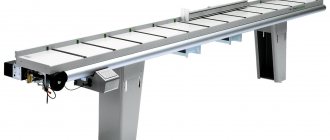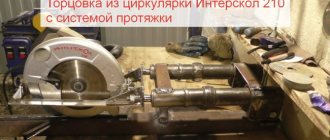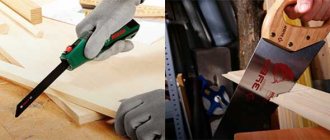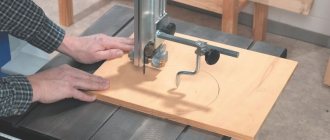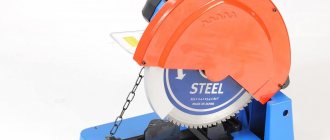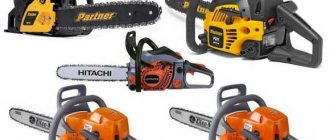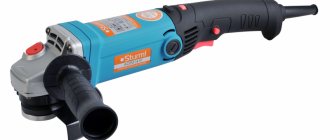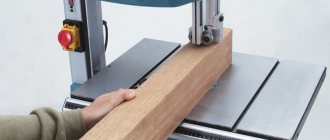A circular saw is a universal carpentry tool designed for cutting any type of wood in a short time. With the support of the master, Andrey Perepelkin, we checked several dozen circular papers. As a result of tests and checking customer reviews, we prepared a rating of the best circular saws of 2021. The TOP includes the most successful and reliable models to date. We considered only hand-held universal circular saws for home use.
Thanks to its special design, the saw can guarantee precise straight cuts at any angle. Traditionally, the best equipment for cutting wood is produced by the Japanese company Makita. Next in terms of reliability are the companies HITACHI, BOSCH, DeWALT, ZUBR, HAMMER. The manufacturer Bosch has a blue tool - this is a professional tool, which means it is made of higher quality and more reliable, the green series is a tool for the home, also of high quality, but the components are simpler.
Technical characteristics of circular saws
When choosing a circular saw for your home, first of all pay attention to the technical characteristics that are given below.
Motor power
Power affects the performance of the tool. The higher this indicator, the thicker the products can be cut using a saw.
If you need to spread the board lengthwise, then the power needed is from 1600 W.
In carpentry, there are 3 classes of circular saws, depending on power:
- Up to 1000 W – lightweight and compact devices designed for cutting plywood or thin boards.
- 1000 – 1500 W – semi-professional saws for use on a small construction site. Suitable for cutting small beams, logs or thick boards. If used at home, such a saw will last longer than a low-power one.
- From 1500 W – a professional tool with a long engine life allows you to work up to 6 hours a day with breaks.
Disc rotation speed
A characteristic that affects the speed of operation. Most often, this indicator directly depends on engine power. When processing hardwood at high speeds, the risk of jamming of the working element due to the resistance of the material is reduced. Semi-professional models have a rotation speed of 5200 - 6000 rpm - this is a good indicator for purchase.
Cutting depth
One of the main criteria for choosing a circular saw is the cutting depth of the material. A characteristic that directly depends on the power and diameter of the cutting disc. When purchasing a household saw, the maximum cutting depth will not exceed 55 mm, and a professional tool will easily cut wood 80 mm or more thick.
- From 40 to 46 mm , which is considered a shallow depth, and a tool that satisfies this parameter is a household one.
- From 50 to 55 mm – the saw is capable of cutting thick floorboards or small bars.
- From 65 to 70 mm – using the tool you can cut non-load-bearing elements of the frame of a wooden house.
- From 65 to 140 mm - a professional saw that can quickly cut small beams or several boards at the same time.
Working at an angle
This characteristic most likely relates to the base of the device rather than to the saw itself. The bed on some hand saws has skids and a locking mechanism to allow you to set the angle of inclination, which is convenient when working with doors, baseboards or furniture.
Which sole (platform) is better?
All experts write that a cast sole is best. But saws with good cast soles are expensive.
The main thing is to look at the quality of the sole, and not at the production method. Even if the sole is forged, but thick and hard, then such a sole is no worse than a cast one.
Circulars costing up to 5,000 rubles generally have flimsy stamped soles.
Saws with a price of 5,000-10,000 rubles are cast or stamped, but thick and hard!
Battery type
Wireless, battery-powered devices allow you to cut wood in any hard-to-reach place. Although it sounds like an advertising slogan, it is truly a useful type of tool. If you deal with sawing work once every six months, then a cordless saw is of no use to you; this category of saws is more suitable for professional use.
There are two main types of batteries for household power tools:
- Lithium-ion (Li-Ion) are modern batteries that do not lose capacity after replenishing energy at any level of residual charge. The downside is low frost resistance - the battery loses efficiency when used in subzero temperatures (this is in theory). In practice, people calmly work with them in both cold and hot weather.
- Nickel-cadmium (Ni-Cd) batteries are obsolete but still widely used. To replenish the capacity, they require complete discharge, but at the same time, they are convenient when working in extreme conditions. It is better not to buy such batteries, and there are not many of them left on the market.
Battery voltage - there are 3 main types on sale - 10.8 V, 12 V, 18 V. As a rule, the higher the voltage created inside the battery, the more powerful the tool. The best batteries on the market are considered to be products from brands such as Metabo and Bosch. Before purchasing a new battery, you need to study what voltage range a particular device is designed for.
Do you need a level or a laser pointer?
This option allows you to accurately adhere to the cutting path when operating the tool, since the beam indicates the direction of movement of the saw. However, the presence of such equipment does not guarantee an ideal result, since its achievement depends on the experience of the master and the steadiness of his hand when working.
Criterias of choice
So, which model of circular saw should you choose for your home? The first thing you should pay attention to is the technical characteristics of the device. The main parameters of circular saws include: power, depth of cut, rotational speed of the cutting tool, capabilities and availability of additional functions. Let's look at the selection options in more detail.
Design specifics. The following types of circular saws are divided depending on the design:
- stationary. It is advisable to buy such a tool for large volumes of the same type of work (at enterprises when processing lumber in large quantities). The instrument is placed on a frame that requires a separate space, and sometimes even a room, for installation;
- desktop _ These are stationary saws, only “in miniature”, installed on the table. Used in everyday life, when performing significant volumes of lumber processing (in the construction of a bathhouse, house, outbuildings, etc.);
- manual - mobile devices that allow you to work even with a small workpiece in different planes. This tool is used for cutting workpieces not only from wood, but also from soft metal or plastic. The power of circular saws in this category is the lowest and requires periodic rest.
Power. The power of the device is the determining factor in determining the depth of cut and the permissible density of the material being processed. The more power the device has, the better. Manufacturers install power units on their models, the power of which depends on the intensity of use:
- household - up to 800 W;
- universal - from 800 to 1.2 kW;
- professional - from 1.2 to 5 kW.
It should be understood that a more powerful powertrain provides better performance, stability and continuous runtime. Weight. Power affects not only the performance of the device, but also its weight and size. You should not chase very powerful models, which may simply be inconvenient to perform certain types of work. For example, to perform most roofing work, specialists use compact and ergonomic battery models.
Cutting depth. This parameter directly depends on the diameter of the cutting disc used in the circular saw. The larger the disc, the thicker and more massive workpieces can be processed. However, in order to spin a large cutting tool and maintain its rotation speed at the desired level, more torque will be required, and as a result, a more powerful motor. The cutting depth depends on the diameter of the cutting disc. Based on this, manufacturers assemble their models with electric motors of a certain power, each of which supports a certain cutting depth:
- Household - provide a cutting depth of 40-50 mm. Used for sawing sheet materials;
- Universal. This indicator varies between 50-60 mm. Used to solve a wide range of problems;
- Professional - allow you to process workpieces with a thickness of 65–140 mm.
Speed. The rotation speed of the cutting blade affects the quality of the cut. The higher the better. However, we should not forget that the higher the shaft rotation speed, the lower its torque. When sawing material, the cutting tool inevitably heats up, and the higher the speed, the higher the temperature. For example, plastic tends to melt at high temperatures, which can cause the disk to jam and the engine to fail.
Adjustment of bevel cut. One of the important points when choosing the right circular saw for your home is the ability to make miter cuts. This function is provided by the design of the platform, which can change its position relative to the axis of the cutting disk. Depending on the model, the tilt can be adjusted to 30, 45, 55°. The platform position is adjusted using a thumb or clamping mechanism.
Ability to work with metal. Most general-purpose (semi-professional) circular saws can process metal by installing an abrasive or toothed carbide blade. Compared to an angle grinder, this tool has many advantages:
- Higher cutting quality and accuracy;
- Convenience when performing work;
- Possibility of cutting at an angle;
- No sparks.
The disadvantages of cutting metal with a circular saw are the high cost of consumables.
Case material. In the production of circular saw bodies, manufacturers use impact-resistant materials that can withstand high loads and temperatures. Among the most common are:
- Metal - typical for professional equipment;
- Heat-resistant plastic - lightweight, which is a characteristic feature of household appliances;
- A mixture of metal and plastic is considered by experts to be an ideal option. Metal increases the life of the tool, and plastic significantly reduces its weight.
Diameter and type of cutting discs. Accessories are the main and consumable element of any circular machine. The performance of the device and the quality of the cut depend on its quality, tooth design and diameter. There are different types of saw wheels:
- Monolithic . Without soldering, may have a sharp or curved tooth. Withstands several re-sharpenings. Used for cutting wood;
- Carbide . Carbide brazing provides the tool with greater functionality and durability. However, they require professional sharpening on specialized equipment.
The outer diameter can vary from 130 to 250 mm. The maximum diameter of the equipment is limited by the dimensions of the protective casing of the device. Depending on the purpose, saw wheels can have 10, 12, 24 and 40 teeth.
Additional functions.
Modern circular models are equipped with serious functionality, among which the most popular are:
- Constant speed maintenance system. The controller reads the shaft rotation speed, when it drops (for example, when entering an area with a more viscous and dense material), the electronics automatically increases the speed due to the power reserve of the device;
- The soft start system allows you to reduce starting currents and the load on the electrical network. The equipment smoothly picks up speed, thereby increasing the resource of the gearbox and the life of the tool;
- The overload protection system will automatically stop supplying power if the motor windings overheat;
- The electrodynamic brake stops the rotation of the equipment at the end of the sawing process. This option increases operator safety when using the tool;
- The slip clutch eliminates the possibility of a kickback and failure of the power unit when the disk jams;
- Protection against accidental activation is an additional button to turn on the device. To start the device, you need to simultaneously press the start buttons, which is almost impossible to do accidentally;
- The spindle stopper makes it easy to replace accessories using just one key;
- The parallel fence and guide rail allow the operator to perform straight cuts parallel to the edge with the highest quality;
- The spring-loaded casing completely hides the equipment, releasing the saw blade only when it rests on the workpiece;
- Adjusting the idle speed allows you to manually select the best process parameters for cutting a particular material.
Don't forget about ergonomics. There are models specially designed for left-handers. Pay attention to the handles. They can be made in the form of a staple, have a straight or mushroom-shaped design. Regardless of the shape, the handles must have anti-slip pads.
Which circular saw to choose for your home or garden?
Purchasing a new circular saw can be a real problem for a beginner, given the large selection, range of prices and product parameters at the retail outlet. When choosing the most suitable tool, you should be guided by the following principles:
- If a tool is constantly needed in a country house or at home to perform standard construction or finishing work, a circular saw with an average power of 1500 W and a cutting depth of at least 55 mm is suitable. If you need to spread the board lengthwise, then the power needed is from 1600 W.
- If thin pine boards, for example, lining, as well as laminate or plywood, are to be cut, then a power of up to 1000 W with a cutting depth of up to 40 - 45 mm will be quite sufficient.
- If you need to make cuts in hard-to-reach places where you need to hold the device suspended, the best solution would be to buy a cordless tool with a small diameter saw blade.
- When it comes to building a wooden house and long-term use, it is better to opt for professional equipment with a power of 1.9 - 2.2 kW.
- If you need to create an opening under the sink or hob in the kitchen countertop, you should use a jigsaw.
- If you need to constantly harvest wood for large construction projects or for sale, you should consider purchasing a stationary circular saw.
The final purchasing decision depends on the type of intended use and the type of activity of the master. If the work involves woodworking, in most cases, only a professional tool is suitable, but for household use 1 – 2 times a month, you should opt for budget, inexpensive models.
Features of a hypoid saw
This type of saw belongs to the category of manual saws and its design replicates many classic models of circular saws. At the same time, there are differences in the components: the engine location is not perpendicular, like most classic models, but lobar, like the so-called “monkeys”.
To ensure proper operation, a hypoid type of transmission is used, which contributed to the formation of the name.
- One of the main disadvantages is the relatively large weight of the structure.
- At the same time, many experts note that this type of chainsaw is more convenient to use, thanks to maximum balance.
- At the same time, the undeniable advantage is ease of use, which helps make it indispensable in a private home or country house.
The best corded circular saws
Circular saws are very popular among consumers, and people often share positive and negative reviews with each other. As a rule, the quality of the product greatly depends on the brand under which the power tool is manufactured. The best models are presented below in descending order.
Classic circular saws with a cable for connecting to the network are widely used in construction and repair.
1
Makita 5008MG, 1800 W
Rating:5.0
- Power: 1800 W
- Disc diameter: 210 mm
- Rotation speed: 5200 rpm
- Functions: backlight
- Weight: 5.1 kg
Average price: RUB 12,987
The first place in the ranking goes to a manual circular saw for the home from Japan. Molded sole. The saw operates from a standard AC mains voltage of 220 V.
The powerful device produces a rotation speed of a disk with a diameter of 210 mm up to 5200 rpm with a cutting depth of up to 75 mm.
The bed can provide bevel cuts in 3 positions - 90, 45 and 22.5 degrees, as well as cutting depth, thanks to the ability to adjust in 2 directions.
The built-in dust collector will keep the work area clean.
The ergonomic rubberized handle fits well in the hand, allowing you to work for a long time, and a bright light will help illuminate the cutting line to improve cutting accuracy.
The working body of the saw is covered with a folding steel casing, guaranteeing safety during operation. The casing does not jam or cling.
When changing the disk, the spindle is securely locked, which reduces the risk of injury.
There is nothing superfluous in the saw.
2
BOSCH GKS 190, 1400 W
Rating:4.9
- Power: 1400 W
- Disc diameter: 190 mm
- Rotation speed: 5500 rpm
- Functions: engine braking
- Weight: 4.2 kg
Average price: RUB 9,137
Second place goes to a hand-held circular saw from Germany, whose engine can reach a speed of 5500 rpm.
The device is capable of cutting through a layer of wood up to 70 mm thick at a right angle and 50 mm at a 45-degree inclination. The disc size is 190 mm with a mounting hole size of 30 mm.
The saw weighs only 4.2 kg, which allows it to be used not only on horizontal, but also on vertical surfaces, as well as in hard-to-reach places.
The device has a built-in dust collection option, as well as automatic blowing away of sawdust that interferes with work.
The circular saw is equipped with a convenient steel stand with markings that help you set the exact position of the cutting line for any type of wood.
The disc replacement process occurs while the spindle is locked, which guarantees complete safety.
3
DeWALT DWE560B, 1350 W
Rating:4.8
- Power: 1350 W
- Disc diameter: 184 mm
- Rotation speed: 5500 rpm
- Functions: vacuum cleaner connection
- Weight: 3.7 kg
Circular saw ergonomics
For household needs, a hand-held circular saw is most often used, which means that special attention must be paid to the issue of ergonomics. At the same time, it will not be possible to give any unambiguous recommendations, since everyone has their own concept of convenience.
Lefty-righty
About 10% of people on Earth are left-handed, and manufacturers must take this into account when producing mirrored models of instruments.
Handle shape and position
If the rear handle is more or less standard, then there are at least three varieties of the front handle: straight, mushroom-shaped and staple-shaped. The first is more suitable when working with a saw “from yourself”, the second is more convenient to drive the saw from the side, and the third is universal, but larger in size than a mushroom-shaped one.
Straight.
Mushroom-shaped.
Staple-shaped.
Rubberized handles
They do not slip in your hands and help you better control the work process.
Observation area
It depends on the design features of each tool, so before purchasing it is better to evaluate it with your own eyes.
Sawdust removal
This is done by blowing sawdust from the work area or by connecting an industrial vacuum cleaner to the saw.
Power cord
To prevent the wire from getting twisted, at least near the saw itself, the cable is taken out of its body through a long and rigid input sleeve.
Replacing carbon brushes
It is not required so often, but in any case it is better if there is a special window for this operation. Additionally, the brushes can be self-switching - when the graphite rod is ground off, the circuit breaks, and there may also be an indication of the status of the brushes.
Saw blade
An important part of the tool that comes into contact with the material being processed. It differs in several ways:
- Alloy. Carbide discs are used to work with wood and its derivatives. Soft alloy - for processing metal workpieces, such as profile sheets;
- Soldering. Saw blade without soldering for straight cuts in soft woods. Hard metal tipped wheels are used for working with hard wood, plastic, metal - they cut everything;
- Number of teeth. The more teeth, the smoother the cut. For example, for plywood - 140 teeth. For wood and laminated chipboard, 56 is enough. For simple housework, an inexpensive disc with 40 teeth is suitable;
- Tooth sharpening angle. For wood, discs with a positive sharpening angle are used, in the direction of rotation. For metal, nozzles with a negative sharpening angle are used, against the direction of rotation.
Electric circular saw review
The design is unified and differs little from one manufacturer to another:
- Frame. It contains working elements;
- Electrical engine. Responsible for power;
- Gearbox. Transmits torque from the electric motor to the saw blade;
- Saw blade. Replaceable module, selected based on the material to be processed;
- Protective cover. Located above the saw wheel, protects the operator from fragments and destruction of the disc;
- Steel base. A flat platform designed to obtain a straight cutting line;
- Riving knife. Located at the rear of the saw wheel. Performs protective functions.


